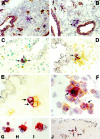Human decidua contains potent immunostimulatory CD83(+) dendritic cells
- PMID: 10880386
- PMCID: PMC1850207
- DOI: 10.1016/S0002-9440(10)64527-0
Human decidua contains potent immunostimulatory CD83(+) dendritic cells
Abstract
Dendritic cells (DCs) are sentinel cells of the immune system important in initiating antigen-specific T-cell responses to microbial and transplantation antigens. DCs are particularly found in surface tissues such as skin and mucosa, where the organism is threatened by infectious agents. The human decidua, despite its proposed immunosuppressive function, hosts a variety of immunocompetent CD45 cells such as natural killer cells, macrophages, and T cells. Here we describe the detection, isolation, and characterization of CD45(+), CD40(+), HLA-DR(++), and CD83(+) cells from human early pregnancy decidua with typical DC morphology. CD83(+) as well as CD1a(+) cells were found in close vicinity to endometrial glands, with preference to the basal layer of the decidua. In vitro, decidual CD83(+) cells could be enriched to approximately 30%, with the remainder of cells encompassing DC-bound CD3(+) T cells. Stimulation of allogeneic T cells in a mixed leukocyte reaction by the decidual cell fraction enriched for CD83(+) cells, was similar to that obtained with blood monocyte-derived DCs, demonstrating the potent immunostimulatory capacity of these cells. Decidual DCs with morphological, phenotypic, and functional characteristics of immunostimulatory DCs might be important mediators in the regulation of immunological balance between maternal and fetal tissue, leading to successful pregnancy.
Figures






References
-
- Billingham RE: Transplantation immunity and the maternal fetal relation. New Engl J Med 1964, 270:667-672 - PubMed
-
- Mincheva-Nilsson L, Baranov V, Yeung MM, Hammarstrom S, Hammarstrom ML: Immunomorphologic studies of human decidua-associated lymphoid cells in normal early pregnancy. J Immunol 1994, 152:2020-2032 - PubMed
-
- King A, Wellings V, Gardner L, Loke YW: Immunocytochemical characterization of the unusual large granular lymphocytes in human endometrium throughout the menstrual cycle. Hum Immunol 1989, 24:195-205 - PubMed
Publication types
MeSH terms
Substances
LinkOut - more resources
Full Text Sources
Research Materials
Miscellaneous

